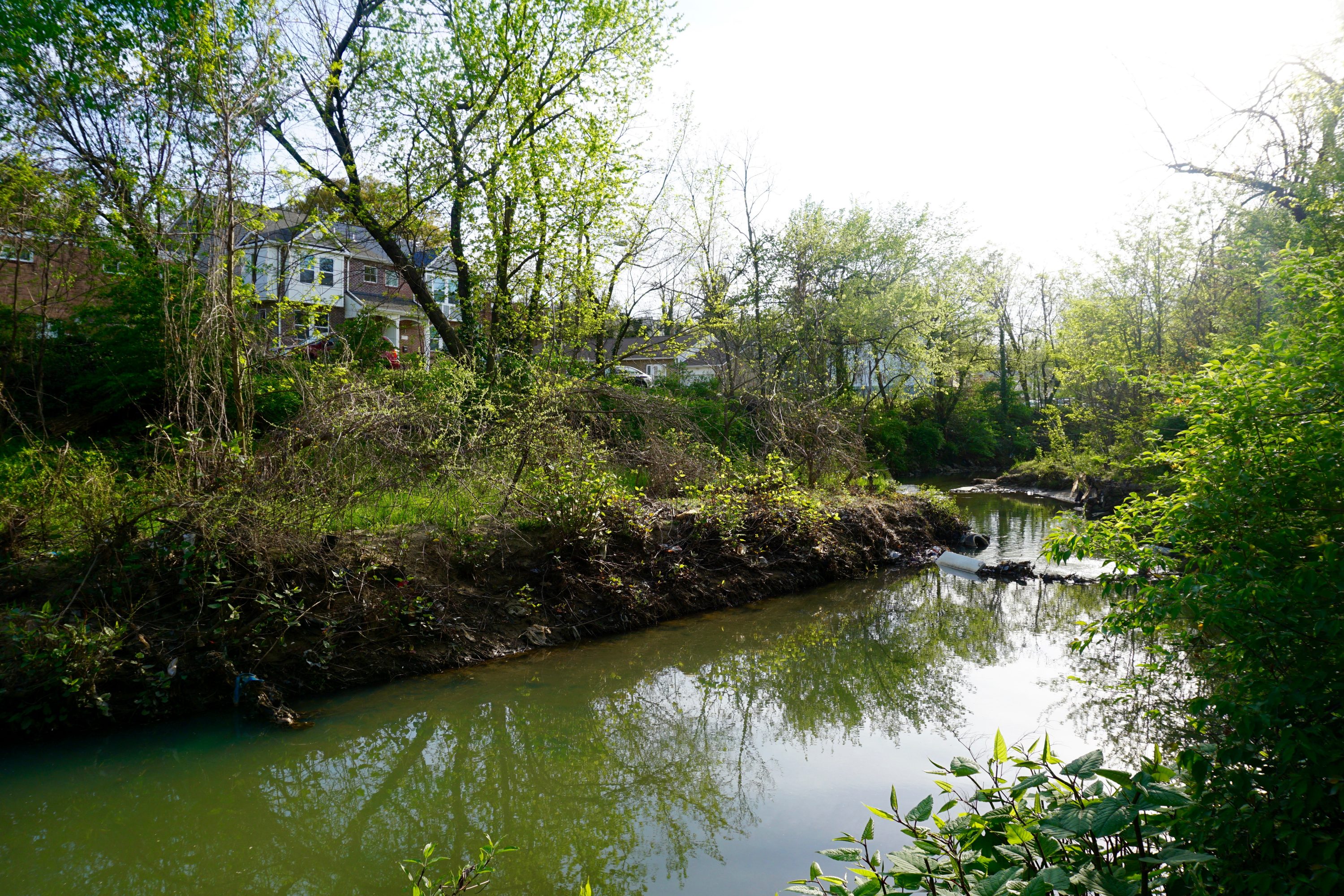Dennis Chestnut has lived in the far northeast corner of Washington, D.C., since he was born. He speaks with pride about its history as one of the most diverse areas of the city and its community resources like Marvin Gaye Park and the Mayfair Mansions, the first property built for African Americans by African Americans in D.C. “I’m still in my boyhood home. People ask me about that and I say, ‘Well, Warren Buffet still lives in his boyhood home as well,’ so I have that to relate with,” he said, eliciting a laugh from the small crowd gathered at the Georgetown Law Center.
Chestnut was speaking about his experiences as a self-described “civic ecologist” in Ward 7 on an April 16 panel hosted by the Georgetown Environmental Law Society. The Anacostia River is the ward’s western border, and the river’s longest tributary, Watts Branch Creek, meanders through the center of its communities.
On sunny days, people walk their dogs while ice cream trucks park next to basketball courts alongside the creek. On rainy days, the waters of Watts Branch can rise to dangerous levels, flooding roads and homes. The D.C. Department of Energy and Environment (DOEE) has predicted that these rainy days, along with a myriad of other effects such as longer, more intense heat waves, will only intensify in the coming years due to climate change.
In partnership with the Georgetown Climate Center (GCC), DOEE brought together 13 Ward 7 community members over six months in 2018 to explore how the area should combat the effects of climate change. But the group went a step further and focused on how climate change intersects with and amplifies the systemic challenges African American communities already face in the city.
The initiative, called the Far Northeast Ward 7 Equity Advisory Group (EAG), has helped move the national discourse around equity and environmental justice to the forefront of climate change preparation efforts in D.C. Although the project officially ended in September 2018, DOEE, GCC, and EAG members hope to carry the momentum of their conversations into the future.
One of the biggest challenges in addressing climate change worldwide is how to equitably reduce and prepare for its effects. Finding the balance between fulfilling immediate needs and preventing future harm is a questions both at the national level and for local communities. Chestnut, who was among the first members of the EAG, remembers encouraging people in the ward over a decade ago to swap their incandescent light bulbs for more environmentally friendly compact fluorescent lights. One woman, he recalled, was not particularly interested.
“She said, ‘I’m trying to keep my lights on, you’re talking about a different bulb and saving the polar bears,’” she told him. “That was her priority, and I had to respect that,” Chestnut said.
Chestnut was able to work with the woman to switch the bulbs, but Ward 7 will be facing even more direct challenges to its environment in the coming years. The Anacostia River has already seen record flooding in the past years, said Trey Shepard, outreach director of Anacostia Riverkeeper, a non-profit organization focused on preserving the river. More severe rain storms in the future and sea level rise will both lead to increased flooding in the communities along Watts Branch and could overload the city’s stormwater management system.
Socioeconomic factors can determine how well a community or individual is able to prepare for and adapt to climate change, Shepard said. The median income in the ward is about half that of the District’s as a whole, according to the Census Bureau.
“Things that are acts of God, or man-made acts of God as we’re starting to see with weather, they can be absolutely devastating,” he said. “If people don’t know where their next meal is coming from, they’re just not in a position to talk about something that’s abstract [like climate change], even if it’s not abstract, even if it is flooding their basement.”
D.C. is expected to have almost triple the number extreme heat days—95 degrees or above—by the 2050s compared to now. These heat waves have a disproportionate effect on the elderly, sick, and those who cannot afford to keep their air conditioning running, according to the National Weather Service.
In 2016, the city introduced the “Climate Ready DC” plan, a strategy to adapt to climate change in conjunction with the city’s plan to cut greenhouse gas emissions, which is called “Clean Energy DC.” Climate Ready DC included a risk assessment of the city at the ward level. As part of the plan, DOEE overlaid physical vulnerabilities to flooding and heat waves—infrastructure in flood plains, important resources like water treatment facilities—with individual vulnerabilities—age, health, income—and identified the areas at greatest risk from climate change.
One of the five priority areas identified was the land around Watts Branch Creek, which begins in Capitol Heights, Maryland, and flows another five miles into the Anacostia River. DOEE and GCC planned the Far Northeast Ward 7 Equity Advisory Group to hear community input on how best to implement the District’s two climate change plans. But Jennifer Li, a climate fellow at Georgetown’s Harrison Institute for Public Law who works with GCC, said that EAG members prioritized their more immediate interests, such as workforce development and improving public safety.
“Given all the concerns or priorities that community members face, why should climate change be on the list?” she said at the April 16 panel at the Law Center. Yet the priorities of DOEE and the community were not necessarily mutually exclusive. “You don’t have to address climate change at the expense of workforce development, for example,” Li continued. “How can it go hand in hand?”
EAG and DOEE were tasked with finding ways to create a resilient environment and community. The 13 EAG members ranged from a high school student to retirees, from new residents to fifth-generation Washingtonians. The group was also selected to be representative of the community—92 percent of the ward is black, and 92 percent of the group was black. Other considerations included members’ gender and the type of housing they live in.
Chestnut has advocated for environmental issues in the area for decades and helped recruit other members. “I saw it as an opportunity to engage with new residents because that was something we were focused on doing, getting residents to the table who had traditionally not been there,” he said.
The EAG met six times from December 2017 to September 2018. They were each provided with a stipend, meals, and childcare during the meetings. These services distinguished the EAG from other community workshops he has participated in, Chestnut said, as they allowed the EAG to include a greater swath of community voices. GCC also brought in neutral facilitators to lead the discussions and contracted with a consultant to monitor the group’s cohesion and progress.
The evaluation consultant, Francella Chinchilla of the Raben Group, identified a “trust handicap” between the EAG members and DOEE in the first weeks of the program in mid-project evaluations filled out by EAG members. When some members learned that the District had already finalized its climate adaptation and mitigation plans and that the EAG was just supposed to implement them, they wrote that they were discouraged that they had not been involved in the initial planning process.
Chestnut said that this distrust partly stems from generations of unequal treatment by the government toward African American communities. He referenced government medical experiments on black people across the United States and federal favoritism of white D.C. communities back when the city had no elected officials until the 1970s.
“One of the most important things you can do is don’t have a preconceived agenda and listen to the community,” he said. “Find out what is important to them and then go from there.”
That approach led to the EAG’s top three proposals: create neighborhood “resilience hubs,” enhance workforce development programs, and invest in youth education and employment. To create the proposals, the EAG refined the goals of the city’s Climate Ready DC and Clean Energy DC plans to fit Ward 7.
Justin Lini, a member of the Ward 7D Advisory Neighborhood Commission during the term of the EAG, was one of the members working in a small group on the resiliency hub recommendations. Resiliency hubs are centers where residents can access resources such as internet, air conditioning, and medical supplies during inclement weather. The EAG recommended placing the hubs in trusted community spaces like churches and partnering with established community leaders to provide ongoing services. Lini said that it was important for the EAG to recommend the District supplement existing community resources rather than come in with a new, top-to-bottom program.
“One of the issues we have out here is that there are a lot of people who do great grassroots work, but then you have a new program come up and it will offset their resources, it will displace them,” he said. “So we need to bring the power of community leaders to this.”
The EAG’s other two recommendations, workforce development and youth engagement, used a similar process. They linked the EAG member’s top priorities for the community with DOEE’s main climate concerns. EAG members called for job training programs in fields that would help real estate developers meet the city’s stringent environmentally friendly building codes. They also recommended the expansion of “green certification” programs in skilled trades like plumbing or solar installation to teach vocational skills to youth who may not go to college.
For example, Lini referenced a job program to help workers develop the skills to fix the city’s stormwater system in preparation for future floods. Lini explained that initiatives like this can have multifaceted effects on the ward.
“One [is] building up better stormwater management,” he said. “But also, at the same time, you employ people, and that increases the resiliency of the community, people have more resources to fall back on.”
By the end of the six-month period, the EAG members were optimistic about their recommendations’ potential to benefit the community in the future, according to Chinchilla’s evaluation. But some members of the group felt they had not had enough time to adequately address race and justice.
“We need to have more explicit and open conversations on race and power,” wrote one EAG member in their final evaluation. “In order for anyone to move forward, truly with equity, you have to start with the heart in order to create space for anything else to come in.”
Members need to be engaged in the process of planning the agendas and purpose of an equity advisory group, Chestnut said. He believes that bringing community members in just for the implementation of finalized plans, like in the Ward 7 EAG, limits the community’s ability to drive the conversation in the most important direction.
Some members also wrote in their evaluations that they were worried about if and how the city government would follow through with the recommendations. Li said DOEE and GCC have ongoing quarterly calls with the EAG members to update them on any work toward their proposals. The city can learn from this process to improve community engagement initiatives in the future, she said. The team built important relationships with each other throughout the process that Li hopes DOEE, GCC, and EAG can maintain and use to bring their recommendations to fruition.
“Over the course of the engagement process, we worked hard to build strong relationships with our partners in the community,” Li wrote in an email to the Voice. “The important thing now is for us to keep maintaining and strengthening those connections as the project moves ahead.”
The project team has begun to share the lessons they learned with other District organizations in the hope that similar initiatives can grow from the successes and failures of the Ward 7 EAG process. In February, the team shared a community engagement guide with other District agencies based on the EAG initiative. In the lead-up to the April 16 symposium at the Law Center, Li and Chestnut led a group of Georgetown students on a tour of the community resources and history of Watts Branch and Ward 7. Lini said he was excited to see a step toward a pilot program to explore the group’s resiliency hub recommendation.
The District has become one of the most aggressive jurisdictions on cutting greenhouse gas emissions and preparing infrastructure for stronger storms and hotter days in the future. In January, Mayor Muriel Bowser signed a bill that requires all D.C. electricity to be sourced from renewable sources by 2032, one of the most ambitious timelines in the country.
Along with D.C., cities around the nation like Portland, New Orleans, and New York are exploring how to ensure that those most vulnerable to climate change have the resources to protect themselves. Governments and communities will have to navigate complicated legal and financial obstacles to respond to a problem that will most impact their descendants, not current advocates.
But Chestnut said the labor over the decades is worth it.
“I have six children—they’re all grown, thank goodness—and I have 15 grandchildren,” he said. “My focus on the work I’m continuing to do is with them in mind.”






Excellent article. Thanks GCC or digging a little deeper